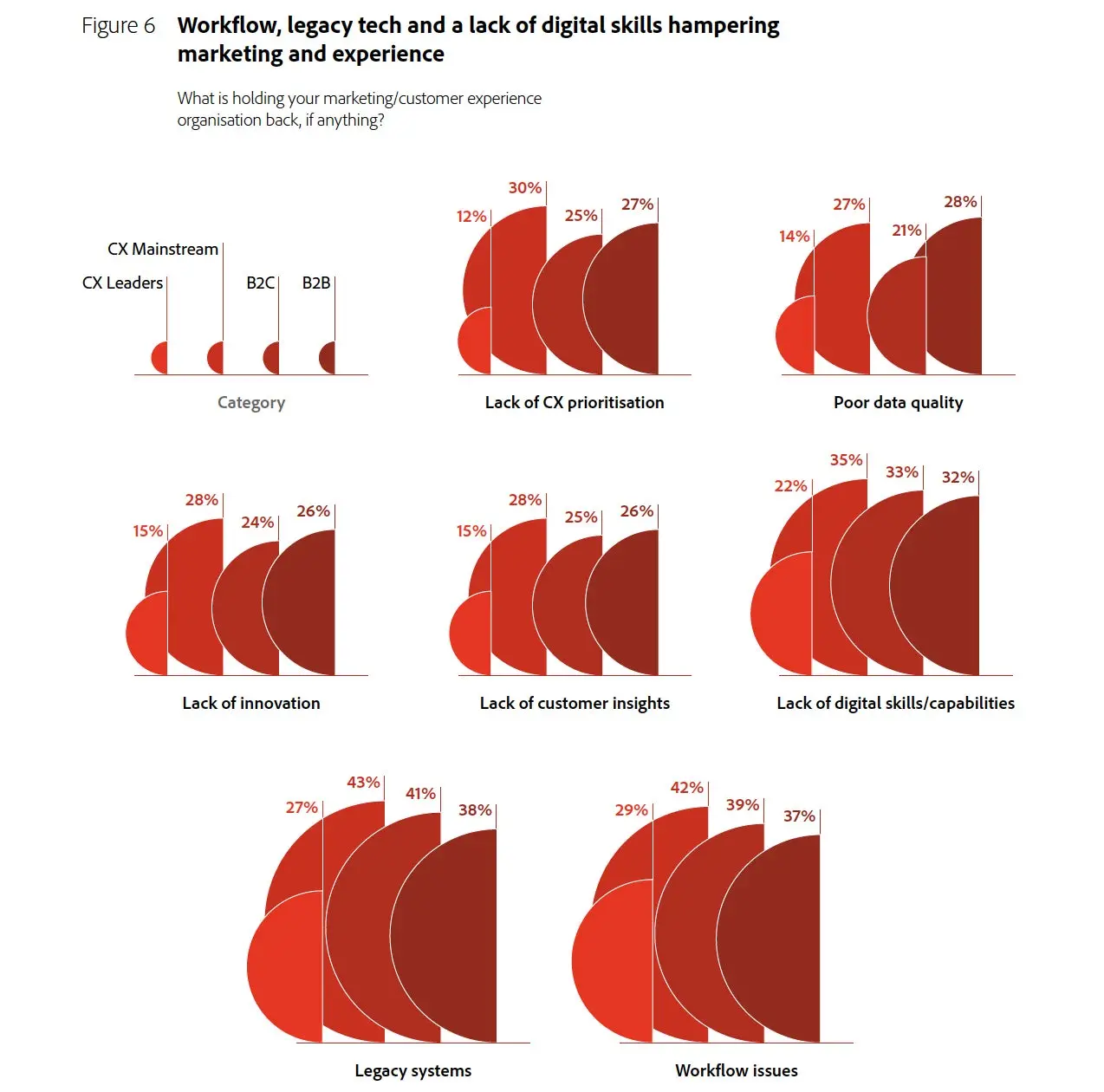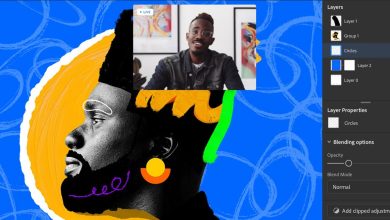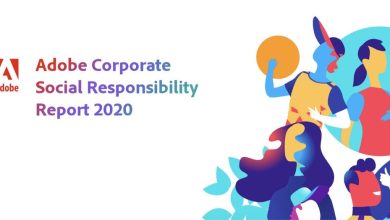Upskilling SEA businesses for a digital-first world — 3 human skills marketers need to deliver great customer experiences

To build a customer experience advantage, marketers need to be savvy about data analytics, change management, and storytelling skills.
The COVID-19 pandemic hasn’t just sped up the pace of digital transformation — it has also shined a powerful spotlight on the customer experience (CX). An increase in remote work, new online customers, and changes in buying behaviors means Southeast Asia (SEA)’s businesses need to carefully consider the future of work. They need to source the talent, develop the skills, and organize the teams that can bring a digital-first CX strategy to life.
Even before the pandemic, SEA businesses were concerned about the digital skills gap. It’s easy to be overwhelmed with the increased pace of change, the explosion of digital channels and technologies, and rising customer expectations. When Econsultancy and Adobe surveyed marketing and technology leaders for our 2021 Digital Trends Report, both CX leaders and mainstream companies ranked “lack of digital skills” as the third-highest issue holding back their marketing/customer experience organization.
But the future of work is not only about technology. In our new digital-first world, customers expect the brands they do business with to deliver digital-led experiences specifically tailored to their needs and preferences. Brands must invest in the right skills as well as the right technologies to meet those sky-high expectations.
According to our 2021 Digital Trends report, a lack of digital skills and capabilities is a problem that’s three parts human and only one part technology. The more than 13,000 respondents to the survey see their businesses as focused on the customer as a human being, their employees as critical assets, and the digital customer experience as the driver of growth and strategy. More than two-thirds of companies that already had strong CX capabilities outpaced their competition in the second half of 2020 — and these CX leaders were three times more likely to have done so “significantly.”
The pandemic has created even more urgency around reskilling and upskilling initiatives. An April 2021 McKinsey study found that 69 percent of organizations have doubled down on their efforts to reskill or upskill employees since the COVID-19 pandemic began.
Upskilling SEA workers to digital work is key to establishing a successful digital future for the region, and it will require a concerted effort among technology companies, higher education, and government. Within organizations, technical upskilling is only part of the solution. To build a customer experience advantage, marketers need to be savvy about data analytics, change management, and storytelling skills. Focusing on these three areas will help your organization deliver impactful experiences at every stage of the customer journey.
According to the 2021 Digital Trends report from Econsultancy and Adobe, a lack of digital skills and capabilities is a problem that’s three parts human and only one part technology.
Contents
1. Data analytics — turning data into insight you can act on.
Plenty of people have technical skills, but there aren’t enough who understand what the data is telling them in their particular business context so they can decide what to do with it. You can think of that need as a marriage of traditional analytical skills and technology.
There are a massive number of digital skills programs out there that train people in coding, business intelligence tools, and collaboration tools. But it’s probably easier to take someone who already understands your business and teach them about data analytics, rather than hiring somebody who has the technical skills but will need to learn your business. Digital upskilling isn’t just about training a new generation of workers. It’s about taking the workforce you already have, keeping them relevant, and bringing them along with you.
One example of this is the Adobe Programmatic League we run in Southeast Asia. We introduce existing members of the workforce to data and analytics to help them understand the possibilities and get them interested in learning those skills and applying them to their functions. It’s taking people with business knowledge — the ones who are already making decisions but aren’t as fully supported by technology and data as they could be — and empowering them by bringing them into the world of data analytics. They learn how they can transfer those capabilities to their organization in this new world of CX, where so much of what we all do is moving online. It’s becoming a world of data and insights, and more and more people are needed who understand how to extract value from data.
We also support other regional and national initiatives, such as SkillsFuture Singapore, where we partner with the government agencies to deliver digital skills induction and enablement programs to the Singapore population. It’s an on-ramp to the world of CX. We show them what our Adobe solutions can do for them and give them an awareness of how other customers have used them to access better insights about their customers.
The Singapore government has invested heavily in digital upskilling for several years, and the results are impressive. The December 2020 APEC Closing the Digital Skills Gap Report presented in-depth analysis of five economies: the United States, Australia, New Zealand, Singapore, and Canada. According to the report, Singapore has the highest digital scores by industry of any of the five economies except for the professional, scientific, and technical industries, where it’s second to Canada by a small margin.
Artificial intelligence (AI) and machine learning are also transforming CX management and helping organizations quickly derive insights from large volumes of data. AI automates certain very advanced processes and lets people access the power of technology without having to spend years learning programming languages and data science. For example, Adobe Sensei is our AI engine that powers features built into Adobe’s products across our three lines of business. It puts the power of AI and machine learning within reach of organizations that don’t have a large team of in-house data scientists.
It’s probably easier to take someone who already understands your business and teach them about data analytics, rather than hiring somebody who has the technical skills but will need to learn your business.
2. Change management — investing in tech to deliver better customer experiences.
Adobe is a cloud company, which means we have to deliver success to keep our customers. We sell solutions that are changing marketing. The companies that are getting the most value out of Adobe solutions, or any digital marketing or CX technologies, are those that are making change management a conscious area of focus.
Change management — making change that is successful and sustainable — is a methodology and a learnable skill. It’s also a mindset. Everyone who’s involved in implementing a new technology should understand they are in a change program. They need to know how to make the change successful. If you don’t approach it that way, you’ll fail — you won’t get the full value out of your technology investment, and you won’t succeed in building a customer-first organization.
We’ve worked with the Singapore Tourism Board (STB), an excellent example of an agency changing its industry through data and analytics. Even before the pandemic, STB realized the tourism industry needed more technology, data, and insights to be more efficient and profitable. The idea was to create a centralized data and insights platform to help the country’s travel and tourism ecosystem move into the digital age. We helped STB build the Singapore Tourism Analytics Network (STAN) and integrate it into the Singapore ecosystem. It’s a great example of an organization taking the leadership on change and coordinating the industry through that change process, so they see the value and benefit from it.
At our recent Adobe Summit, I had a conversation with Nathan Bell, Chief Digital Officer of M1 Limited — a leading telecommunications operator (telco) in Singapore — about M1’s ongoing digital transformation. He said it took a while for people at M1 to understand that they were part of a major change initiative. “At the beginning everyone was convinced this was just a technology thing — we’re just going to replace our old systems with new systems and I’ll keep doing my job. I think over time, though, there’s been a deep realization that it actually starts with ourselves as the team that’s working within M1 to be able to serve our customers.”
Everyone who’s involved in implementing a new technology should understand they are in a change program. They need to know how to make the change successful. If you don’t approach it that way, you’ll fail.
3. Storytelling — remembering that the customer journey tells a story.
It’s also critical that marketers have strong storytelling skills, both internally, to get all the teams aligned around the customer journey they’re trying to create, and externally, to deliver the right messages to customers at each stage of their journey with the brand.
A compelling example of internal storytelling is Adobe’s own data-driven operating model (DDOM), which aligns the organization around a five-stage customer journey: discover, try, buy, use, and renew. The customer’s story defines how the internal teams service that customer across the whole organization.
Once you’ve taken the time to really understand the customer journey, organize your people so that each team is attending to it in a consistent way. This approach is a powerful way of showing empathy for your customers, and it also lines up all the necessary data logistics to support the entire customer journey.
It’s powerful to show people that the customer journey is a story in itself. If somebody takes the time to document that story and articulate it, and then gets everybody in the organization to understand that customer story, then everyone realizes how they should be supporting that story — what their roles and responsibilities are, and how they coordinate it all to make it a smooth journey.
As for external storytelling, the DDOM approach allows Adobe marketers to provide tailored recommendations to Adobe Creative Cloud customers at every stage. We get granular at the product level and the segment level, so we can tell different stories for those different segments and take consumers through the customer journey.
Maybe we recognize that a particular individual or segment of individuals is doing more than an average person, so we shift the story. For example, we may suggest that an amateur videographer using Adobe Rush might be ready to try the more advanced video editing tool, Adobe Premiere Pro. Or we may discover a bunch of people who are deciding to go on a new career journey and become vloggers. That would be a slightly different story.
You can only get to that level of empathy when you gather all the data and identify segments. That’s what allows you to tell the right story. It’s essential to link all these insights from an external point of view so that you can engage customers with the right level of empathy throughout the entire customer journey.
Once you’ve taken the time to really understand the customer journey, organize your people so that each team is attending to it in a consistent way. This approach is a powerful way of showing empathy for your customers.
Establishing a successful digital future in Southeast Asia
The SEA region is a fast-growing digital market, and we need to upskill the workforce to digital work rapidly. If you look at the demographics, we have both a growing middle class and many young people needing jobs, so there’s a lot of demand.
It’s also significant to consider COVID-19’s impact on the travel and tourism industry, which makes up a substantial amount of the region’s employment and GDP. The pandemic disruption shows us we can’t rely on that industry to survive forever. We need to reskill and upskill people with the digital skills they need to build successful careers in other industries, and also help transform the future of tourism.
M1 has made a conscious decision to not just bring in fresh, external talent with digital expertise but to also help current employees learn new digital roles that match how business works today. As Nathan Bell explained, the company’s leadership recognized that a digital transformation is more than just a technology refresh. It was important for them to keep the company’s essence, knowledge, and history on the people side instead of hiring all new employees.
While that type of upskilling is key to establishing a successful digital future in SEA, it will require a concerted effort from different areas — technology companies as well as higher education and government.
Mentoring will also be critical to shifting SEA workers’ mindsets for success in today’s economy. I’m part of a group of professionals that mentors young Singapore undergraduates and recent graduates on how to be successful in the workplace. The 12-month program is very successful, partly because it’s well-screened and targets people who can benefit most from this type of help. It’s also very well-structured in terms of leading the mentees to provide mentors with data on what they need.
Mentoring is playing an important role in changing cultural attitudes in SEA toward accepting new career paths, including technology jobs, that diverge from cultural norms. It helps both the mentors and the mentees build resilience and a stronger SEA workforce for the digital-first economy.
To learn more about the latest global trends in digital transformation, read the 2021 Digital Trends report from Econsultancy and Adobe.
Source : Adobe









